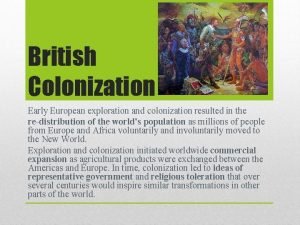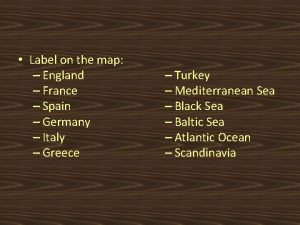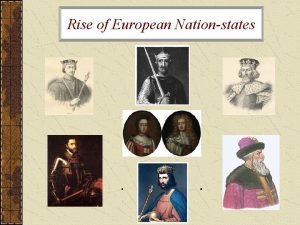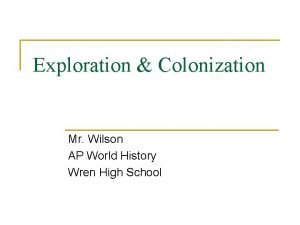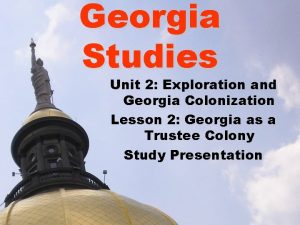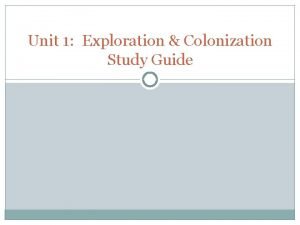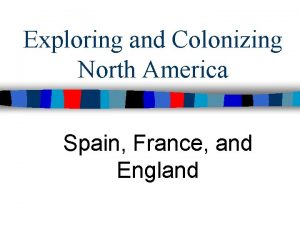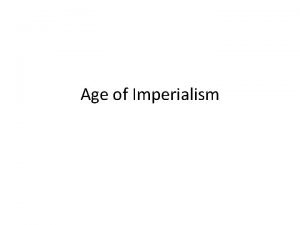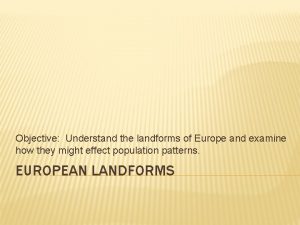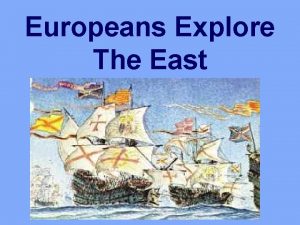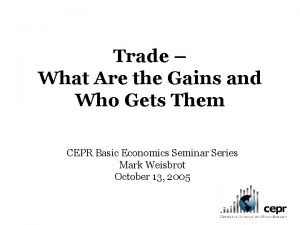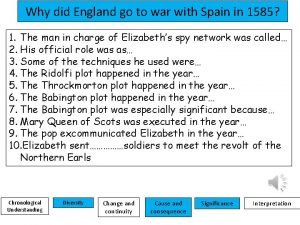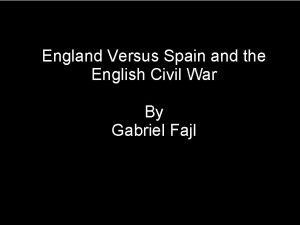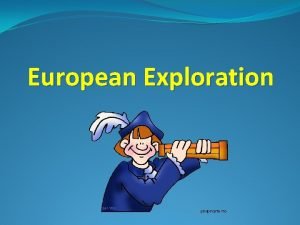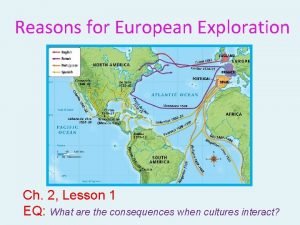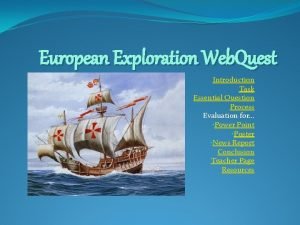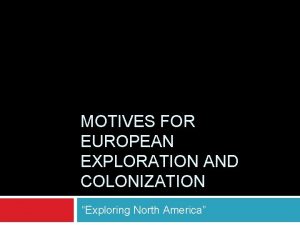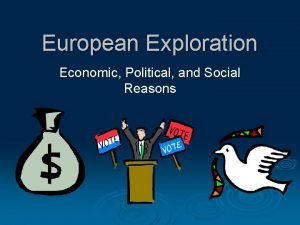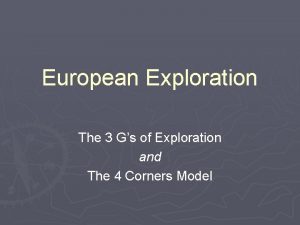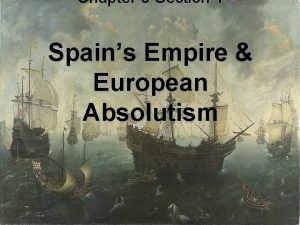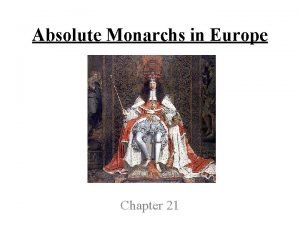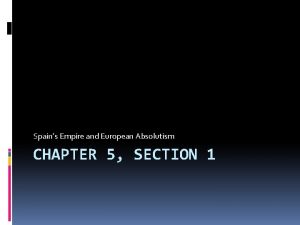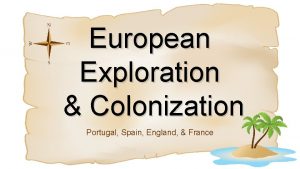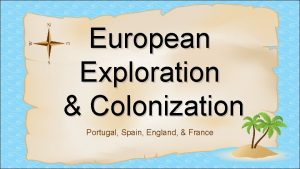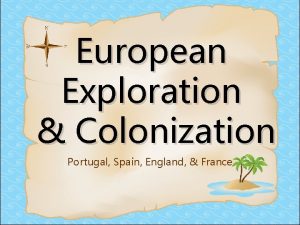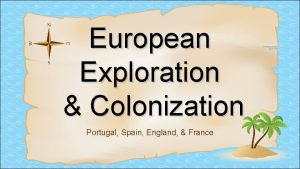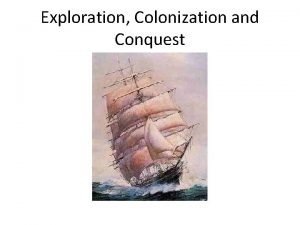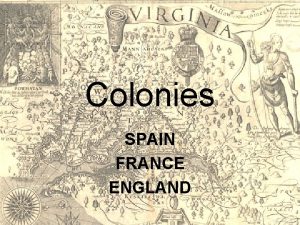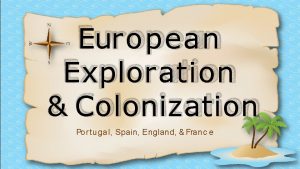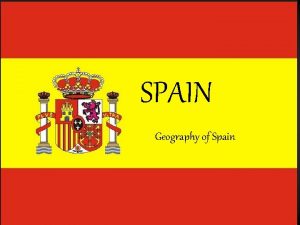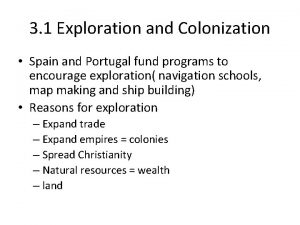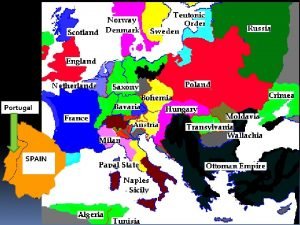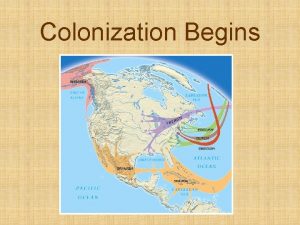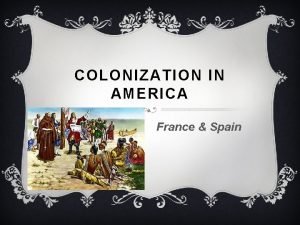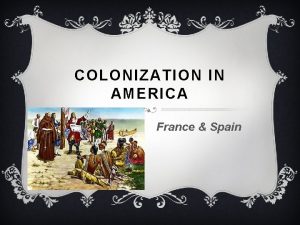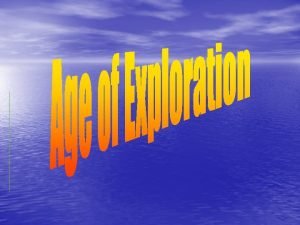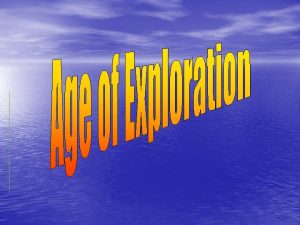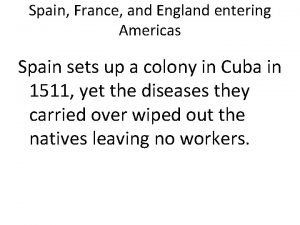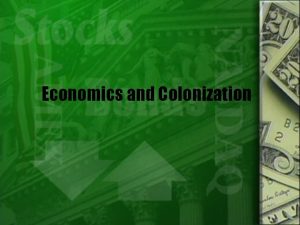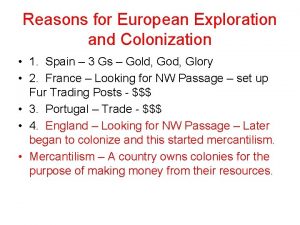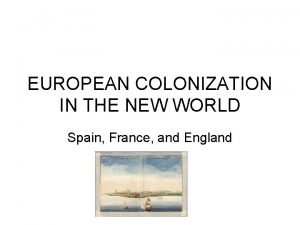European Exploration Colonization Portugal Spain England France The























- Slides: 23

European Exploration & Colonization Portugal, Spain, England, & France

The 3 G’s… Why did Europeans go exploring? 1. GOLD New trade routes opened up opportunities for wealth. 2. GOD Missionaries wanted to spread Christianity. 3. GLORY Explorers were considered famous heroes;

The Crusades • The Crusades were military expeditions sent by the Catholic Church to capture the Holy Land from the Muslim Turks. • They were not successful, but did have a few positive results: 1. Europeans learned to draw better maps and build better ships. 2. Exposed Europeans to spices & goods from the East.

Trade Routes • In the 1400 s, major trade routes from the East to Europe went through 2 Italian cities (Venice & Genoa). • Italian merchants marked up the prices on the goods & sold them throughout Europe. • Other European countries resented the huge profits made by Italians & began to look for other routes to the East…

Trade Routes • Europeans created new trade routes to bring products from Europe to India, China, & the Spice Islands. • This greatly contributed to the expansion of the empires of Portugal, Spain, England, and France.


Portugal’s Empire • 1 n the 15 th century , Portugal led the world in sea exploration and explored the western coast of Africa. • The Portuguese wanted to find a trade route around Africa to Asia because: o They believed they could make a lot of money as traders if they could get Asian goods for a cheaper price. o They also wanted to spread Christianity along

Prince Henry the Navigator • He was the son of the Portuguese king. • He sent more than 50 expeditions down the west coast of Africa. o He wanted to establish Portuguese colonies & break the Muslim hold on trade routes. • He also created a naval observatory that taught students navigation, astronomy, & cartography

Prince Henry the Navigator

Institute of Sagres

Prince Henry the Navigator • He was unable to make much money trading gold, so he tried creating sugar cane plantations. o Sugar cane was a very profitable crop, but required lots of labor. • Prince Henry imported slaves from Africa to work the fields. o This was successful & was later copied in the New World. o His actions encouraged a slave trade that lasted

Portugal’s Empire • For the next 300 years, Portuguese sailors continued to explore Africa where they established forts & trading posts. o By 1571, a string of outposts connected Portugal to Africa, India, South Pacific Islands, & Japan • Portugal grew wealthy from these trade routes, but its most profitable colony was Brazil.

Spain’s Empire • Spanish explorers were searching for a trade route through or around North & South America to Asia. • They wanted to find a quicker route to the gold & spices in Asia.

Christopher Columbus • In the 1490 s, Columbus, an Italian, was given ships & sailors by the Spanish monarchy. o They wanted him to try to find a quick route through the Atlantic Ocean to Asia. • He discovered the Bahamas, but thought he was in Asia. o Later, it was realized that he discovered 2 new continents! • Exploration of these areas brought great wealth to Spain.

Christopher Columbus

Spain’s Empire • Spain had a huge empire that spanned the globe. • Spanish conquistadors conquered the Inca and Aztec civilizations in the 1500 s (South America). o They were looking for gold & spices. o They used missionaries to convert natives to Christianity. • Spain claimed huge areas of North & South America & ruled over them for 300 years.

England’s Empire • In the past, England was one of three countries-England, Scotland, & Wales. • In the 1700 s, the three united and became Great Britain. • The British empire was the largest in history. o At its peak, Great Britain controlled: Canada, Australia, India, much of Africa, and numerous islands all over the world.

England’s Empire • North America came under British control in the 1700 s. o It lost the American colonies in 1776, but maintained control over Canada until the 20 th century. • Great Britain colonized Australia in 1788. o It was used as a penal (prison) colony to relieve overcrowded jails in England.

France’s Empire • France possessed colonies around the world from 1600 to 1900. • It also dominated much of the European continent. o By 1812, France controlled much of Germany and Italy.

France’s Empire • France established other colonies in the 16 th-17 th centuries: • --Islands in the Caribbean, the Indian Ocean, the South Pacific, the North Pacific, & the North Atlantic • France also maintained influence in Canada, South America, Southeast Asia, & Northwest Africa.



Credits: All photos were found via Creative Commons and labeled for reuse. • Fonts: • Backgrounds:
 Early european exploration and colonization resulted in
Early european exploration and colonization resulted in France spain map
France spain map England france spain
England france spain Stern rudder ap world history
Stern rudder ap world history Unit 2 exploration and georgia colonization
Unit 2 exploration and georgia colonization Unit 1 exploration and colonization
Unit 1 exploration and colonization English territories in france
English territories in france Between 1859 and 1893 vietnam
Between 1859 and 1893 vietnam Landforms of europe
Landforms of europe Aztec empire on a map
Aztec empire on a map Prince henry the navigator route
Prince henry the navigator route England and portugal
England and portugal Why did england and spain go to war
Why did england and spain go to war England versus spain
England versus spain God glory and gold
God glory and gold European exploration map
European exploration map What factors encouraged european exploration?
What factors encouraged european exploration? European exploration webquest
European exploration webquest Henry hudson motives for exploration
Henry hudson motives for exploration European exploration economic reasons
European exploration economic reasons Reasons for exploration 3 g's
Reasons for exploration 3 g's Chapter 5 section 1 spain's empire and european absolutism
Chapter 5 section 1 spain's empire and european absolutism Chapter 21 section 1 spain's empire and european absolutism
Chapter 21 section 1 spain's empire and european absolutism Chapter 5 section 1 spain's empire and european absolutism
Chapter 5 section 1 spain's empire and european absolutism
